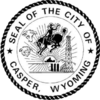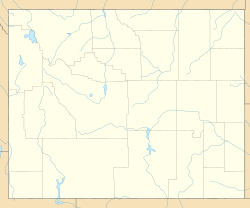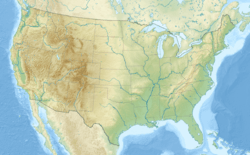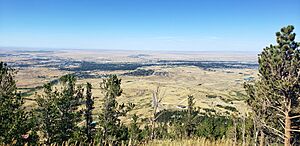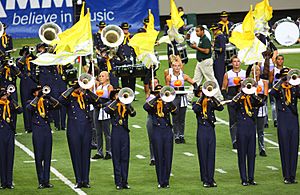Casper, Wyoming facts for kids
Quick facts for kids
Casper, Wyoming
|
|||||
|---|---|---|---|---|---|
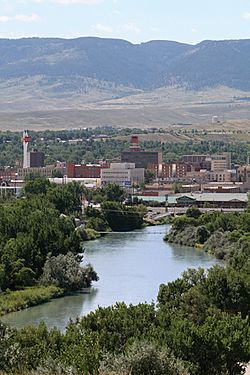
Overview of downtown, looking south toward Casper Mountain, with North Platte River
|
|||||
|
|||||
| Nickname(s):
"The Oil City"
|
|||||
| Country | United States | ||||
| State | |||||
| County | Natrona | ||||
| Government | |||||
| • Type | Council–manager | ||||
| Area | |||||
| • City | 26.88 sq mi (69.62 km2) | ||||
| • Land | 26.55 sq mi (68.76 km2) | ||||
| • Water | 0.33 sq mi (0.86 km2) | ||||
| Elevation | 5,150 ft (1,560 m) | ||||
| Population
(2020)
|
|||||
| • City | 59,038 | ||||
| • Rank | US: 662nd WY: 2nd |
||||
| • Density | 2,182.21/sq mi (842.55/km2) | ||||
| • Urban | 64,548 (US: 424th) | ||||
| • Metro | 79,955 (US: 378th) | ||||
| Time zone | UTC−7 (MST) | ||||
| • Summer (DST) | UTC−6 (MDT) | ||||
| ZIP Codes |
82601–82602, 82604–82605, 82609, 82615, 82630, 82638, 82646
|
||||
| Area code(s) | 307 | ||||
| FIPS code | 56-13150 | ||||
| GNIS feature ID | 1586424 | ||||
Casper is a city in Wyoming, United States. It is the county seat of Natrona County, Wyoming. Casper is the second-largest city in Wyoming. About 59,000 people lived there in 2020.
Casper is often called "The Oil City." It has a long history tied to oil and cowboy culture. This goes back to when the nearby Salt Creek Oil Field was developed. The city is in east-central Wyoming, right on the North Platte River.
Contents
Discovering Casper's Past
Casper was founded east of an old military post called Fort Caspar. This area was popular with European settlers in the mid-1800s. Many people traveled through here on trails like the Oregon Trail, California Trail, and Mormon Trail. Several ferries helped people cross the North Platte River.
In 1859, a man named Louis Guinard built a bridge and a trading post. This made travel easier for people passing through. The government also sent soldiers to protect telegraph and mail services. Lieutenant Colonel William O. Collins led these soldiers.
Native American attacks increased after 1864. More troops came to the post, which was then called Platte Bridge Station. In July 1865, Native American warriors killed Collins's son, Caspar Collins. Three months later, the post was renamed Fort Caspar in his honor.
In 1867, the soldiers left Fort Caspar. They moved to Fort Fetterman further down the North Platte River. However, the town of Casper itself was settled in 1887. It became an official town a year later. Developers thought it would be a key stop for the Wyoming Central Railway.
The original plan was to build the town a few miles east. A homesteader named Joshua Stroud lived there. The Pioneer Town Site Company set up the site in 1888 and called it Strouds. But the name Casper soon became more popular. The name "Casper" comes from Fort Caspar and Caspar Collins. It's spelled "Casper" because of a mistake when it was officially registered.
Casper became an important trade center. It was a starting point for people involved in the Johnson County War. This was because the train carrying these men stopped in Casper. The city also saw many visitors during the solar eclipse of August 21, 2017. This was because Casper was in the path where the sun was completely blocked.
Casper's Location and Weather
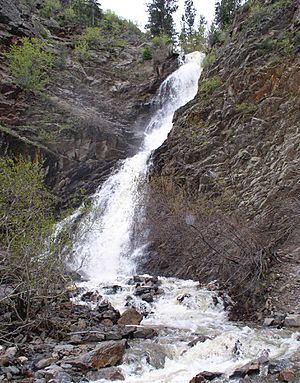
Interstate 25 is the main road to and from Casper. It comes from the north and east. Towns next to Casper include Mills, Evansville, and Bar Nunn.
The city covers about 27 square miles (70 square kilometers). Most of this area is land, with a small amount of water.
Casper's Climate
Casper has a dry, semi-arid climate. Winters are long, cold, and dry. Summers are hot but usually dry. Spring is mild, and autumn is short and clear.
- Temperatures: Daily high temperatures range from about 35°F (2°C) in January to 89°F (32°C) in July.
- Hot Days: The temperature reaches 90°F (32°C) about 38 days a year.
- Cold Days: It stays below freezing about 41 days a year. Lows drop to 0°F (-18°C) about 15 nights annually.
- Record High: The hottest temperature ever recorded was 104°F (40°C). This happened on July 12, 1954; July 16, 2005; and July 29, 2006.
- Record Low: The coldest temperature was -42°F (-41°C) on December 22, 2022.
- Snow: Snow can fall heavily in winter and early spring. It usually snows in May and October too.
- Rain: Most rain falls in spring and early summer, but it's still not a lot.
| Climate data for Casper, Wyoming (Casper-Natrona County International Airport), 1991–2020 normals, extremes 1948–present | |||||||||||||
|---|---|---|---|---|---|---|---|---|---|---|---|---|---|
| Month | Jan | Feb | Mar | Apr | May | Jun | Jul | Aug | Sep | Oct | Nov | Dec | Year |
| Record high °F (°C) | 60 (16) |
68 (20) |
77 (25) |
84 (29) |
95 (35) |
102 (39) |
104 (40) |
102 (39) |
100 (38) |
87 (31) |
73 (23) |
66 (19) |
104 (40) |
| Mean maximum °F (°C) | 50.8 (10.4) |
55.1 (12.8) |
68.1 (20.1) |
76.9 (24.9) |
85.4 (29.7) |
94.3 (34.6) |
99.1 (37.3) |
96.9 (36.1) |
91.9 (33.3) |
80.1 (26.7) |
65.7 (18.7) |
52.8 (11.6) |
99.5 (37.5) |
| Mean daily maximum °F (°C) | 35.2 (1.8) |
37.8 (3.2) |
48.8 (9.3) |
56.3 (13.5) |
66.8 (19.3) |
79.6 (26.4) |
89.0 (31.7) |
86.7 (30.4) |
75.6 (24.2) |
59.7 (15.4) |
45.9 (7.7) |
34.7 (1.5) |
59.7 (15.4) |
| Daily mean °F (°C) | 25.1 (−3.8) |
26.6 (−3.0) |
35.8 (2.1) |
42.3 (5.7) |
52.0 (11.1) |
62.5 (16.9) |
71.0 (21.7) |
69.0 (20.6) |
58.9 (14.9) |
45.3 (7.4) |
34.0 (1.1) |
24.8 (−4.0) |
45.6 (7.6) |
| Mean daily minimum °F (°C) | 15.0 (−9.4) |
15.4 (−9.2) |
22.7 (−5.2) |
28.2 (−2.1) |
37.1 (2.8) |
45.4 (7.4) |
53.0 (11.7) |
51.4 (10.8) |
42.2 (5.7) |
30.9 (−0.6) |
22.0 (−5.6) |
14.8 (−9.6) |
31.5 (−0.3) |
| Mean minimum °F (°C) | −12.2 (−24.6) |
−10.0 (−23.3) |
3.3 (−15.9) |
13.8 (−10.1) |
24.5 (−4.2) |
37.4 (3.0) |
42.9 (6.1) |
40.0 (4.4) |
29.1 (−1.6) |
13.9 (−10.1) |
−2.6 (−19.2) |
−11.5 (−24.2) |
−20.8 (−29.3) |
| Record low °F (°C) | −40 (−40) |
−32 (−36) |
−25 (−32) |
−6 (−21) |
16 (−9) |
25 (−4) |
30 (−1) |
29 (−2) |
16 (−9) |
−9 (−23) |
−27 (−33) |
−42 (−41) |
−42 (−41) |
| Average precipitation inches (mm) | 0.49 (12) |
0.56 (14) |
0.84 (21) |
1.41 (36) |
2.21 (56) |
1.34 (34) |
1.19 (30) |
0.79 (20) |
0.95 (24) |
1.19 (30) |
0.64 (16) |
0.61 (15) |
12.22 (308) |
| Average snowfall inches (cm) | 9.0 (23) |
10.9 (28) |
10.3 (26) |
10.5 (27) |
2.6 (6.6) |
0.1 (0.25) |
0.0 (0.0) |
0.0 (0.0) |
1.5 (3.8) |
7.0 (18) |
8.9 (23) |
11.0 (28) |
71.8 (183.65) |
| Average precipitation days (≥ 0.01 in) | 6.0 | 6.9 | 8.0 | 10.3 | 11.0 | 8.5 | 6.8 | 5.8 | 6.8 | 7.6 | 6.2 | 7.0 | 90.9 |
| Average snowy days (≥ 0.1 in) | 6.1 | 7.5 | 6.8 | 6.0 | 1.6 | 0.0 | 0.0 | 0.0 | 0.5 | 3.8 | 5.6 | 7.6 | 45.5 |
| Mean monthly sunshine hours | 204.6 | 172.3 | 269.7 | 300.0 | 334.8 | 354.0 | 368.9 | 368.9 | 333.0 | 217.0 | 204.0 | 198.4 | 3,325.6 |
| Mean daily sunshine hours | 6.6 | 6.1 | 8.7 | 10 | 10.8 | 11.8 | 11.9 | 11.9 | 11.1 | 7 | 6.8 | 6.4 | 9.1 |
| Mean daily daylight hours | 9.5 | 10.6 | 12.0 | 13.4 | 14.7 | 15.3 | 15.0 | 13.9 | 12.5 | 11.0 | 9.7 | 9.1 | 12.2 |
| Percent possible sunshine | 69 | 58 | 73 | 75 | 73 | 77 | 79 | 86 | 89 | 64 | 70 | 70 | 74 |
| Average ultraviolet index | 2 | 2 | 2 | 2 | 5 | 6 | 6 | 6 | 4 | 2 | 2 | 2 | 3 |
| Source 1: NOAA, Weather Atlas (sun data) | |||||||||||||
| Source 2: National Weather Service | |||||||||||||
Who Lives in Casper?
| Historical population | |||
|---|---|---|---|
| Census | Pop. | %± | |
| 1880 | 40 | — | |
| 1890 | 544 | 1,260.0% | |
| 1900 | 883 | 62.3% | |
| 1910 | 2,639 | 198.9% | |
| 1920 | 11,447 | 333.8% | |
| 1930 | 16,619 | 45.2% | |
| 1940 | 17,964 | 8.1% | |
| 1950 | 23,673 | 31.8% | |
| 1960 | 38,930 | 64.4% | |
| 1970 | 39,361 | 1.1% | |
| 1980 | 51,016 | 29.6% | |
| 1990 | 46,742 | −8.4% | |
| 2000 | 49,644 | 6.2% | |
| 2010 | 55,316 | 11.4% | |
| 2020 | 59,038 | 6.7% | |
| Source: | |||
In 2010, about 55,316 people lived in Casper. There were 22,794 households, which are groups of people living together.
Most people in Casper are White (92.3%). Other groups include African American (1.0%), Native American (0.9%), and Asian (0.8%). About 7.4% of the population is Hispanic or Latino.
About 31.5% of households had children under 18. Many households (46.1%) were married couples. The average household had 2.38 people. The average family had 2.95 people.
The average age in Casper was 36 years old. About 23.9% of residents were under 18. About 12.9% were 65 or older. The city had slightly more females (50.3%) than males (49.7%).
Casper's Economy and Jobs
Casper is a key center for banking and business in its region.
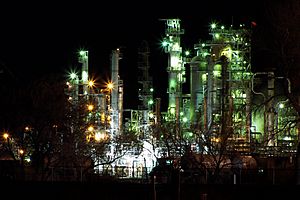
Oil was found in the area in the 1890s. After that, Casper became a major hub for the oil industry. Oil has been very important to the city's history. The first oil refinery in Casper was built in 1895.
Today, the Sinclair Oil Corporation operates a refinery nearby in Evansville. Casper also plays a role in the coal and uranium industries. This helps the city remain an energy center.
The Casper Wind Farm is near the city. It has 11 wind turbines that create electricity. Energy Transportation Inc., a company that moves large wind power parts, is based in Casper. The city's landfill also disposes of old windmill blades.
Learning and Schools in Casper
Casper has Casper College, which is a community college. Students can earn bachelor's degrees in 16 subjects. These degrees are offered through a partnership with the University of Wyoming.
Public schools in Casper are part of Natrona County School District Number 1. This district has 16 elementary schools, five middle schools, and three high schools. The high schools are Kelly Walsh High School, Natrona County High School, and Roosevelt High School. A new program called CAPS is being added. It will give more space and classrooms for older high school students.
Casper also has a public library. It is a part of the Natrona County Public Library System.
Media and News in Casper
Casper has a daily newspaper called the Casper Star-Tribune. There are also online news sites like WyoFile and Oil City News.
The city has 30 radio stations on both FM and AM. KTWO 1030 AM is the oldest radio station in Wyoming.
Casper is served by several TV stations:
- KTWO-TV (channel 2) is connected with ABC.
- KCWY (channel 13) is connected with NBC.
- KGWC-TV (channel 14) is connected with CBS.
- KFNB (channel 20) is connected with Fox.
- PBS also has a station, KPTW, on channel 8.
Most of the city's radio and TV stations broadcast from Casper Mountain. This mountain is south of the city.
Sports and Fun in Casper
Casper has hosted several exciting sports events:
- UFC 6, a mixed martial arts event, took place at the Casper Events Center in 1995.
- The AIFA Championship Bowl III was held at the Casper Events Center in 2009.
- The College National Finals Rodeo has been held at the Events Center since 2001.
The Casper Recreation Center offers many activities. You can play basketball, use the fitness areas, or play racquetball and volleyball. It's next to the Casper Family Aquatics Center and Casper Ice Arena. Soccer matches are played at the Casper Soccer Complex. Golfers can enjoy the Casper Municipal Golf Course, which has 27 holes.
Sports Teams in Casper
- Casper Cannibal RFC: An amateur rugby team.
- Casper Spuds: A collegiate summer baseball team that started playing in 2023. They play at Mike Lansing Field.
Casper's Culture and Arts
Museums and Historic Places
Casper has many interesting museums and historical sites:
- Fort Caspar Museum and Historic Site: Learn about the old fort.
- National Historic Trails Interpretive Center: A museum about the historic trails.
- Nicolaysen Art Museum: See different kinds of art.
- Tate Geological Museum at Casper College: Explore geology and fossils.
- Werner Wildlife Museum: Discover local wildlife.
- Wyoming Veterans Memorial Museum: Honor veterans.
- The Science Zone: A fun place for science.
- Historic Bishop Home: A historic house to visit.
Performing Arts and Music
Casper offers several places to enjoy theater:
- Gertrude Krampert Theatre at Casper College
- Stage III Community Theatre
- Casper Events Center, which hosts touring Broadway shows called Broadway in Casper.
Casper is home to the Casper Troopers. This is a drum and bugle corps that performs in Drum Corps International. The Wyoming Symphony Orchestra also performs here. In the summer, Casper's City Band gives free concerts at Washington Park.
Unique Architecture
The Wyoming National Bank of Casper building is a modern tower. It was designed by Charles Deaton. This building is even featured in Casper's logo!
Getting Around Casper
Major Roads
- Interstate 25: This major highway runs north and south through Casper. It connects to I-90 in Buffalo, Wyoming.
- US Routes:
- US 20: This east-west route runs with I-25 through Casper.
- US 26: This east-west route also runs with I-25 through Casper.
- US 87: This north-south route runs with I-25 through Casper.
- Wyoming State Highways: Several state highways help people travel in and around Casper. These include WY 220, WY 251, WY 252, WY 254, WY 255, and WY 258.
Air Travel
Casper has an airport called Casper–Natrona County International Airport. It used to be an army air base during World War II. The runways are very large because they were built for bombers.
Airlines like United Express and Delta Connection offer passenger flights. FedEx Express and FedEx Feeder provide cargo services. The airport is west of the city. Its facilities were updated in 2004.
Local Transportation
The city of Casper offers public transportation called Casper Area Transit. It has fixed routes called Casper Area LINK. There's also an on-request service called ASSIST. These services run from Monday to Saturday.
Bus Services
You can also find scheduled bus service in Casper. It is offered by ExpressArrow (formerly Black Hills Stages).
Famous People from Casper
Many notable people have connections to Casper:
- John Barrasso (born 1952): A U.S. Senator.
- Zane Beadles (born 1986): A former professional football player.
- C. J. Box (born 1958): A well-known author.
- Tom Brewer (born 1958): A member of the Nebraska Legislature.
- Tom Browning (1960-2022): A former major-league baseball pitcher.
- Taven Bryan (born 1996): A professional football player.
- Dick Cheney (born 1941): A former U.S. Vice President and Secretary of Defense. He grew up in Casper.
- Liz Cheney (born 1966): A lawyer and former member of the U.S. House of Representatives. She attended elementary school in Casper.
- Lynne Cheney (born 1941): The wife of former Vice President Dick Cheney.
- Tom Coburn (1948–2020): A former U.S. Senator from Oklahoma.
- Barbara Cubin (born 1946): A former member of the U.S. House of Representatives. She grew up and graduated from high school in Casper.
- Mike Devereaux (born 1963): A professional baseball player who won the World Series.
- Ron Franscell (born 1957): A journalist and author.
- Mary Meyer Gilmore (born 1947): A former member of the Wyoming House of Representatives.
- Marlan Scully (born 1939): A physicist known for his work in quantum optics.
- Matthew Scully (born 1959): An author and speechwriter.
- Matthew Shepard (born 1976): A person whose story led to important changes in hate crime laws.
- Patrick Joseph Sullivan (1864–1935): A former mayor of Casper and U.S. Senator from Wyoming.
- Floyd Volker (1921–1995): A professional basketball player.
- Pete Williams (born 1952): An NBC News journalist.
- Logan Wilson (born 1996): A linebacker for the Cincinnati Bengals.
Images for kids
See also
 In Spanish: Casper (Wyoming) para niños
In Spanish: Casper (Wyoming) para niños



